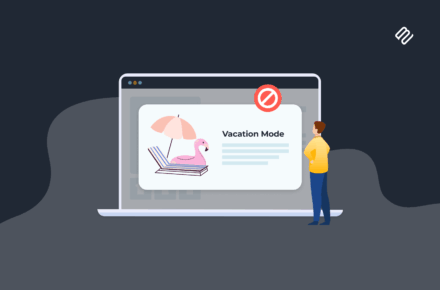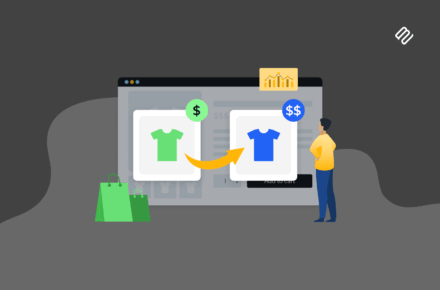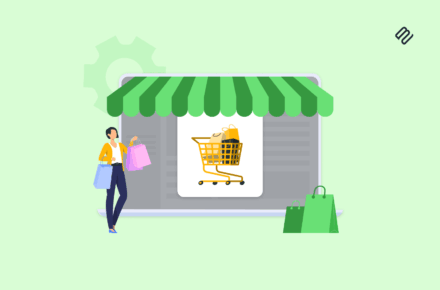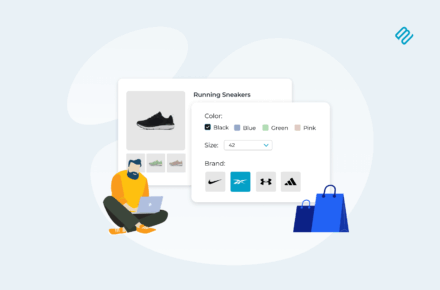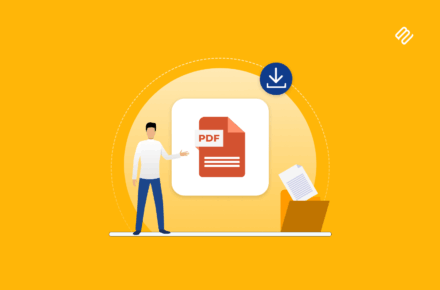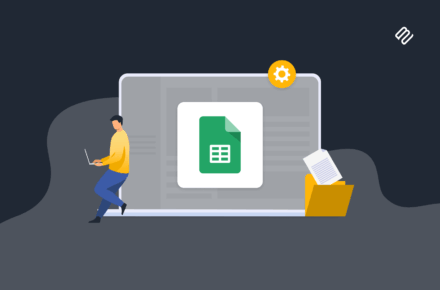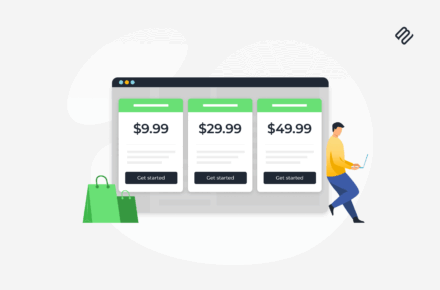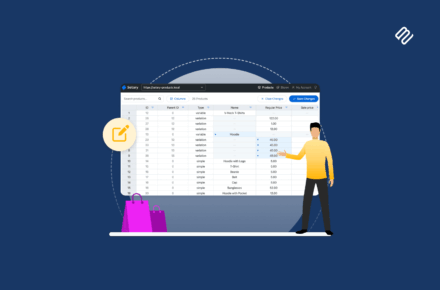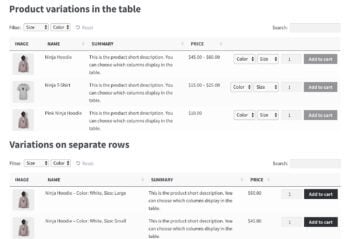
Have you ever noticed how long it takes to add products to the cart in WooCommerce? Customers have to visit a separate page for each product so that they can select quantities, choose variations etc. You can speed up the customer journey by adding a quick WooCommerce bulk order form to your website. To do it, simply install a WooCommerce order form plugin.
Order forms allow customers to view and compare a longer list of products than the traditional WooCommerce layout. For lots of stores, an order form fits aligns better with how customers browse and buy products. They can see everything on one page, compare products and make quick buying decisions. This encourages more sales by enabling customers to shop quickly and efficiently.

WooCommerce Product Table is the perfect way to create a quick order form. In fact, people keep telling me it's the best WooCommerce order form plugin around! We've built a quick order form demo so you can see how it works – go ahead and have a play.
Of course, an order form layout isn't for everyone. In this post we'll help you choose between using a WooCommerce order form plugin and the standard WooCommerce shop layout, so you can rest assured you're creating the ideal product layout for your store. Once you've learned all about WC order forms, I'll provide step-by-step instructions plus a video tutorial on exactly how to set it up.
What is a WooCommerce order form?
By default, WooCommerce displays e-commerce products in a standard format, with each product occupying a relatively large amount of space.
This typical store layout has a grid format with 3 or 4 products per row. Each will have a large featured image, a title, a short description, a price, and an Add to Cart button. Customers click through to a single product page to read more information before adding the item to their shopping cart:
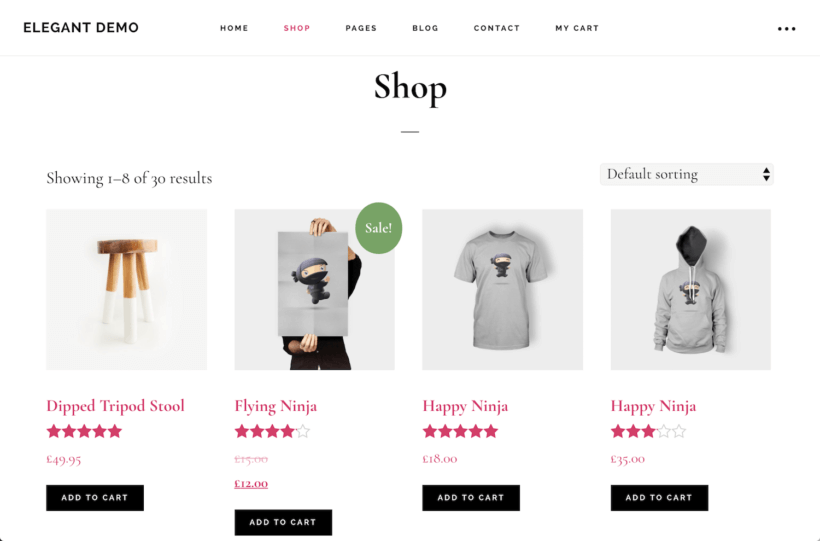
A WooCommerce order form is an alternative way to list products. Presented in a structured table format, each product takes up a single row in the table, and product images are much smaller. The layout is far more compact and often includes extra features, such as sort options and filters. The screenshot below shows what you can create:
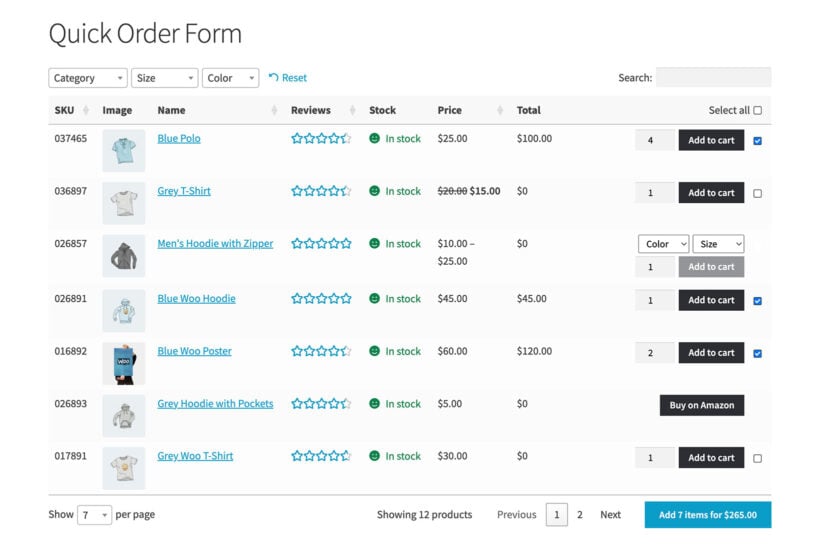
An order form plugin lets you list many more products on a single page than you could in the default WooCommerce store layout. And, instead of clicking through to the single product page, customers can select variations, specify a quantity and add their chosen items to the cart – all directly from the order form.
Boosting sales with an alternative layout
Both the traditional category layout and order form view use the Woo cart and checkout. Once a customer has chosen their products, the process for placing an order is identical.
The real difference is how the products are presented in the first place. This is a key part of the buying process: it's the point when customers are exploring your products and making buying decisions. The layout has a big impact on your sales and conversion rates, so it's vital to choose the right layout for your products.
Comparing the two layout options for listing WooCommerce products, you can see how a WooCommerce order form plugin (or WooCommerce bulk order form plugin) makes much better use of space than a traditional store layout:
Using the product table, you'll fit twice as many products into the same amount of space. Because of the compact layout, it's also possible to fit in plenty of extra features, including filter dropdowns, a search box, sorting, and the ability to select quantities and variations. This is why we often refer to it as a WooCommerce bulk order form – because it's so much easier to order higher quantities.
What sort of websites need a WooCommerce order form plugin?
While the standard WooCommerce shop format is great for some stores, there are many cases when an order form gives customers a better buying experience.
A WooCommerce order form plugin is ideally suited to stores where customers don't want to hang around browsing, but instead want to quickly choose from a list of products. Let customers add multiple products to their carts from a quick one-page order form.
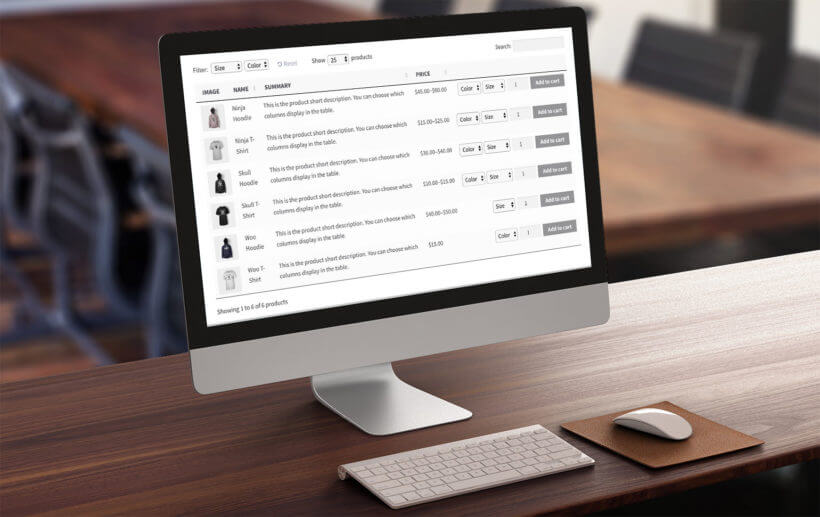
How to create a WooCommerce order form
Watch this video tutorial below to learn how to create a order form in WooCommerce. You can watch me create the exact order form shown on the demo site then create your own on your WooCommerce site! Alternatively, read the quick setup guide or the step-by-step written instructions below the video:
Quick setup guide
- Install the WooCommerce Product Table plugin on your WordPress site.
- Use the table builder to control how you want the order form to work.
- Go to Pages → Add New and add the product table block or shortcode.
- Publish the page and view the WooCommerce order form.
Detailed written tutorial
To start, you need a WordPress website with WooCommerce set up and some products added.
Step 1: Install the WooCommerce order form plugin
Get WooCommerce Product Table, download the plugin zip file, and install it via Plugins → Add New.
Step 2: Create your first order form
The table builder helps you to create your first WooCommerce order form step by step. You can either create 1 order form listing all your products, or multiple order forms listing different products. Alternatively, you can enable the order form layout on your main shop pages instead of creating them one-by-one.
The table builder will open when you first activate the plugin. You can also open it later on via Products → Product Tables.
2a. Decide how to add the order form
Page 1 of the table builder lets you choose which method you'll use to display the WooCommerce order form on your site:
- Add it to a page using a block or shortcode - Do this if you want to create order forms which don't affect your main shop pages.
- Display on a shop page - Do this if you want to enable the WooCommerce order form layout throughout your store.

On the following page, you can then choose exactly which products to display in the WooCommerce order form.
2b. Choose what data to display in the order form
The 'Column' page lets you control which columns appear in the order form. You can display various data about your products including SKU, ID, name, description, short description, date, categories, tags, image, reviews, stock, weight, dimensions, price and buy button. The plugin supports product attributes and custom fields as separate columns in the table, e.g. size or color.
2c. Customize the add to cart column of the order form
You can choose whether the 'Buy' column includes product variations and quantity picker, or whether you want customers to click through to the single product page to view the variations. And if you're using the Product Options plugin to add extra product add-ons, then these will appear in the order form too.
You can also choose whether to have normal add to cart buttons, multi-select checkboxes, or both.
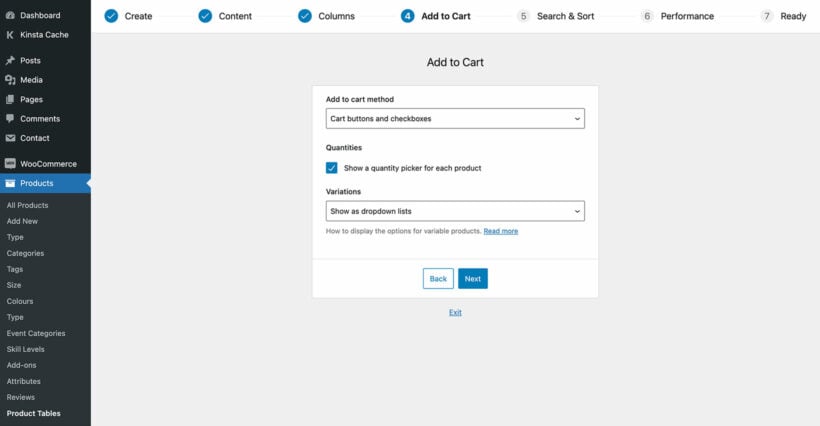
Tip: The plugin settings page at Products → Product Tables → Settings also lets you customize the add to cart button wording. For example, you could reword it to 'Buy' to save space in the WooCommerce order form.
Use filters to help customers find your products
The WooCommerce order form can include filter dropdowns above or filter widgets alongside the table. This lets customers filter by category or product categories, tag or attribute. You can either include all possible filters or choose specific ones to appear.
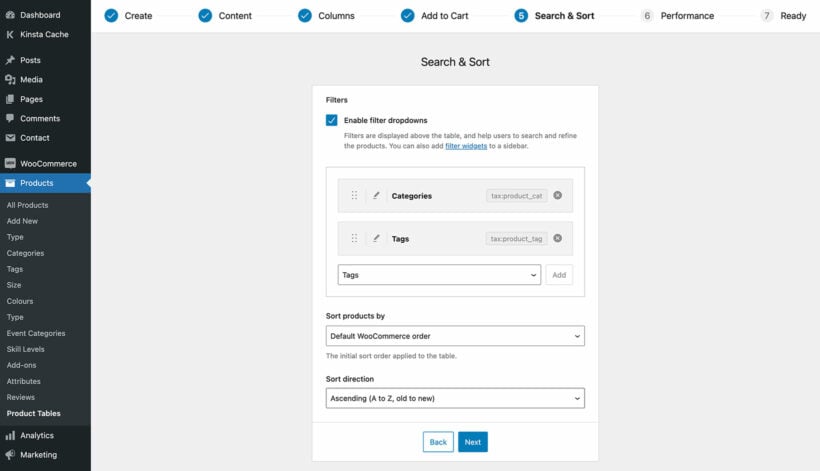
Here's an example of the filters that come with the order forms in Product Table:

Or for even more filtering options, you can use it with our advanced filtering plugin - WooCommerce Product Filters. By using both plugins together, your filters can look more like this:
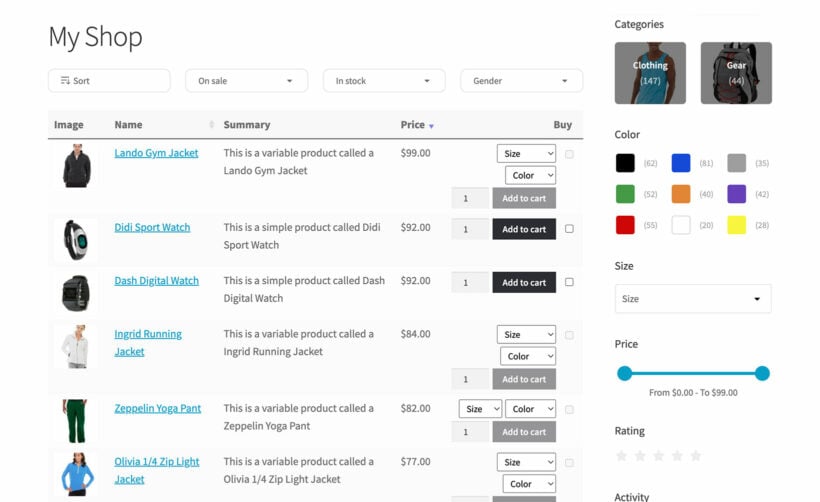
Change the sort order of the products in the order form
You can also choose how the products on the order form are sorted by default. Customers can also sort the products by clicking on a column header.
Use lazy load to improve performance in big order forms
The lazy load option speeds up the order form load time for WooCommerce stores with many products. This uses Ajax to load products one page at a time, so if you have thousands of products then this makes a big difference.
Step 3: Create an order form page(s)
(Note: Ignore this step if you selected for the order form to appear on your main shop pages.)
- Copy the product table shortcode from the final stage of the table builder.

- Create a new page which you will use for your order form.
- Add any content that you like to the page. For example, you can add text or other content above and below the order form. You can also add subheadings (e.g. one for each category) and insert a different order form after each one.
- Go to the part of the page where you wish to add a WooCommerce form. Add the shortcode that you copied above, or insert a 'Product Table' block using the WordPress block editor.
- Publish the page and view it.
On your WooCommerce order form page, you'll see all your products listed in a neat table layout.
If you want to create multiple order forms - either on the same page or multiple pages - then that's fine too. Just create multiple tables, each one listing different pages. You can then insert multiple blocks or shortcodes to list them as needed. 
Step 4: Add bonus features to your order forms
Now we've looked at the essential features for a WooCommerce order form, I'm going to tell you how to supercharge it even further. You can do this by using other plugins to add bonus functionality.
Add an on-page popup cart and checkout
A WooCommerce order form is all about bringing the shopping experience to a single page. For this reason, it makes sense to also bring the cart and checkout experience to the same page!
You can achieve this by adding a cart popup plugin to the order form page. The Fast Cart plugin is designed to work alongside your WooCommerce order form like this:
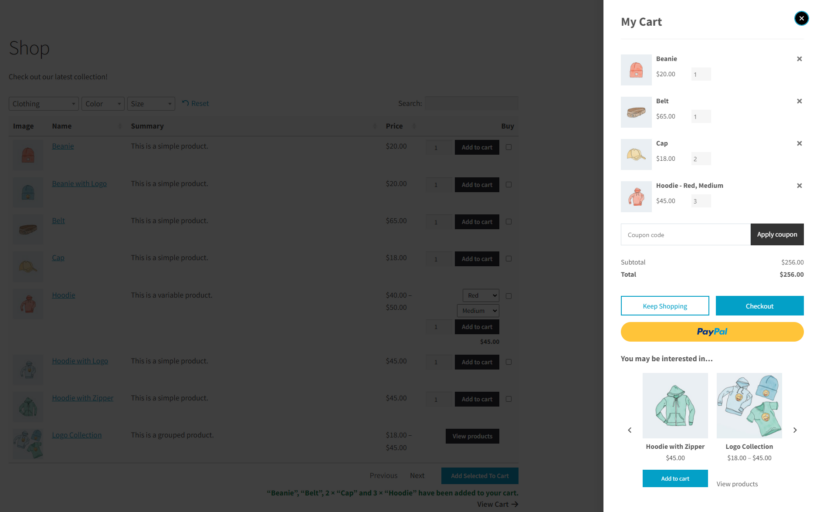
And also this:

Either use it as a popup cart, or skip the cart and open the checkout as soon as customers add products to their cart from the order form. That's the quickest way to shop because customers can add products and complete their order from the same page!
Add product quick view
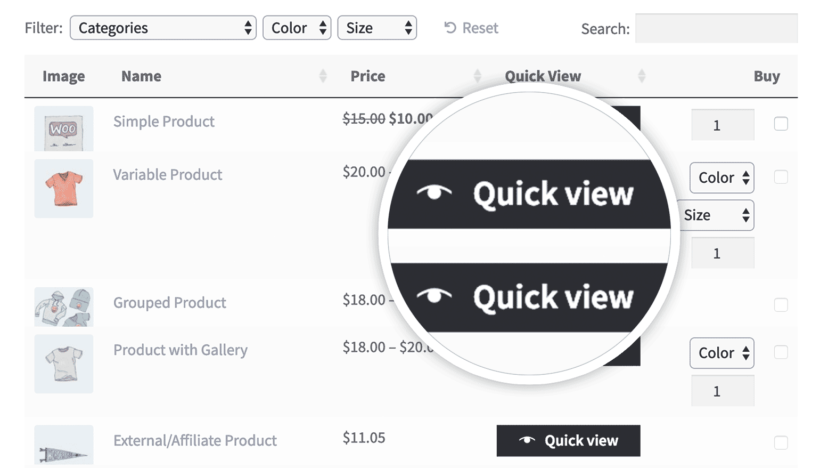
Your order form can contain various columns of information about your products. However, you may want to display extra information that won't fit in the order form layout. Or you may want to sell product variations or other options without cluttering up the order form page.
You can solve this dilemma by using WooCommerce Product Table with the WooCommerce Quick View Pro plugin. This adds quick view buttons or links, which open extra product information and purchase options in a user-friendly lightbox window. It's a great way to show extra information without taking customers away from the order form.
Disable the WooCommerce single product page
By default, customers can click on a product title or image in the order form to view a separate page for each product. Most product order forms don't need this feature. You can disable these links if needed so that the only way to view a product is on the order form page - especially if you're using quick view instead.
Add additional fields and custom fields to the order form
WooCommerce Product Table makes it easy to add additional fields to your order form. This is useful if you need to add media such as PDFs with more information about a product, or you just need other meta information.
We have a full tutorial on how to use WooCommerce custom fields here.
Create a printable WooCommerce order form
Since publishing this article, some of our customers have asked about how to create a printable order form. The idea of this is that customers can print the order form on paper and fill it in manually. They can then post it to place the order the old-fashioned way.
In response, we've created a separate tutorial on how to create a printable order form.
What types of product sell best in a quick order form?
Now we've learned how to use the best WooCommerce order form plugin, let's consider when to use one. After all, all products are different and some lend themselves to the order form layout better than others.
Let's take a look at some examples of when an order form layout is the best way to go:
WooCommerce wholesale order form
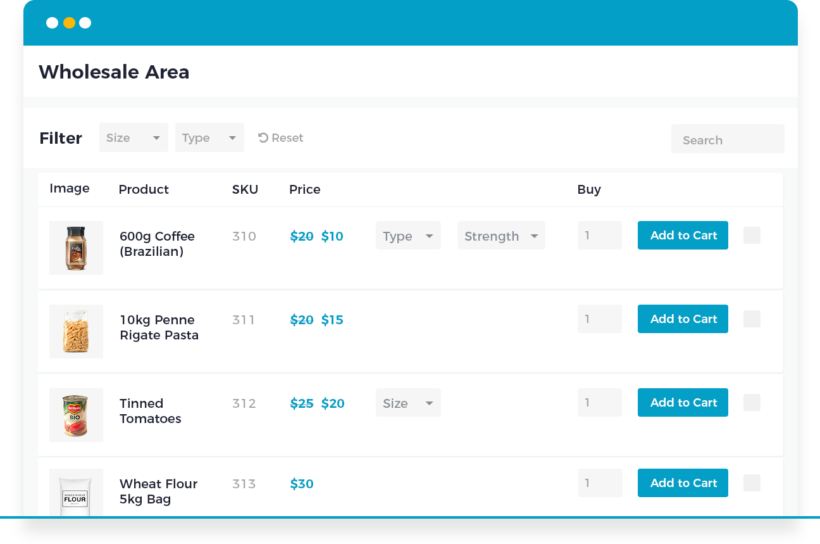
Trade customers typically make regular orders of products they're already familiar with. They don't want to spend ages browsing multiple product pages.
A compact wholesale order form lets them quickly select multiple products and instantly add to cart. This is more efficient than a more traditional WooCommerce product layout, which is too visual and spaced out.
For best results, use WooCommerce Product Table together with its sister plugin WooCommerce Wholesale Pro. Which adds other B2B functionality like wholesale registration and pricing. You can choose whether to enable the order form view for all customers, or just b2b users.
Large product directory
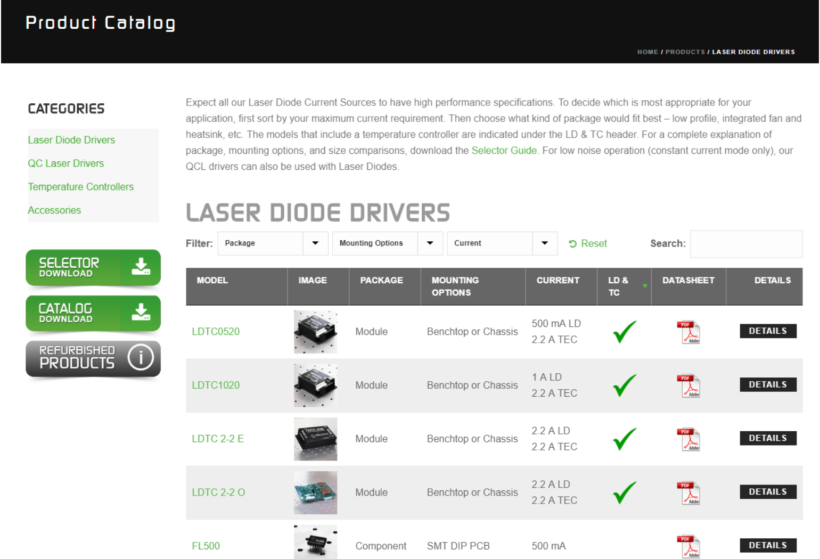
A lot of our WooCommerce Product Table plugin users have HUGE e-commerce stores with thousands of products. A WooCommerce directory plugin is a good way to list large numbers of products in a directory structure.
For example, one website uses WooCommerce Product Table to display thousands of ball bearings for sale. Customers can use the filters to find the type of ball bearing they require based on product attributes such as size and color. They can then tick the products they want, add to cart and buy online. This would be a cumbersome process using the traditional WooCommerce shop layout. Not to mention that large pictures of ball bearings aren't necessary! Check out our tutorial on how to create a WooCommerce product catalogue.
Here's a review from a customer who's increased sales by using Product Table to list thousands of products in a quick order form:
WooCommerce bulk order form
Similar to a wholesale order form, a WooCommerce bulk order form is useful for ordering large quantities of products. If a customer is buying products in bulk, they won't want to browse through the standard WC layout. A product table is perfect as a bulk order form because they can quickly order as many products as they like.
'Build your own product' configurator
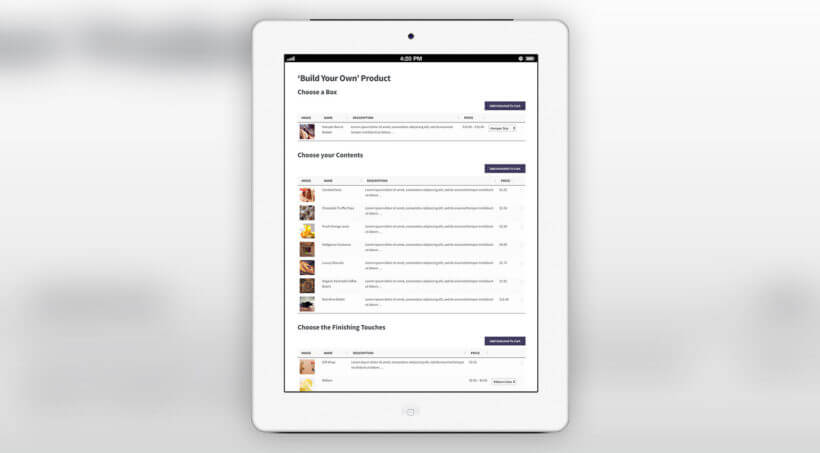
Lots of WooCommerce websites let customers choose multiple items from a list to build a box, create their own pizza, build a luxury hamper, or similar. Customers can select items from a list and add them all to a cart with a single click. An order form is ideal for this 'build a product' format or product configurator.
Case study – using an order form plugin to sell hampers
Barks and Squeaks is an online store selling gifts and treats for fur buddies and their owners. As well as offering individual products, the Barks and Squeaks store sells hampers. To do this, they've created an order form using our WooCommerce Product Table plugin. This enables customers to quickly pack a hamper full of lots of products, without changing pages:
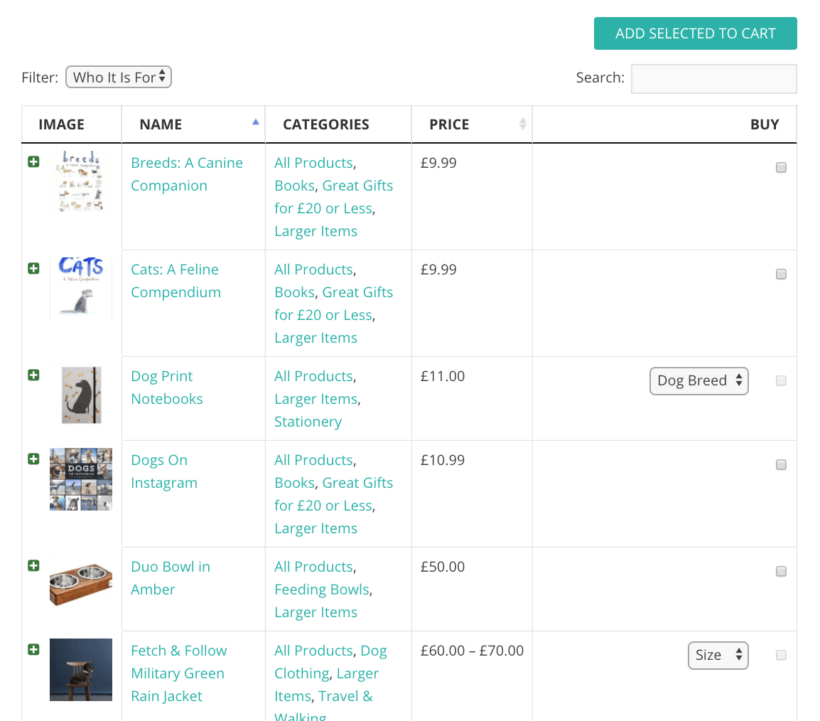
Which WooCommerce stores don't need a quick order form?
As you can see, a WooCommerce order form plugin is the right choice for lots of stores, but it isn't for everyone.
If you answer 'Yes' to any of the following questions, it's worth considering whether the standard WooCommerce shop format is a better fit:
- Does your store only have a few products?
- Do you sell highly visual products that will benefit from big images or multiple images?
- Do customers need to spend a long time reading detailed information about your products before deciding to buy?
As an example, imagine you own an online boutique clothing store. Think about how your customers would use your store. Big images will definitely play a crucial role in encouraging sales. Your customers will also be happy to take their time browsing items and reading detailed product information. They may then go on to make a considered purchase of one, two, or perhaps a few items.
With a WooCommerce order form, customers can click through to a single page for full product information. You can also increase the size of the product images for a more visual table:
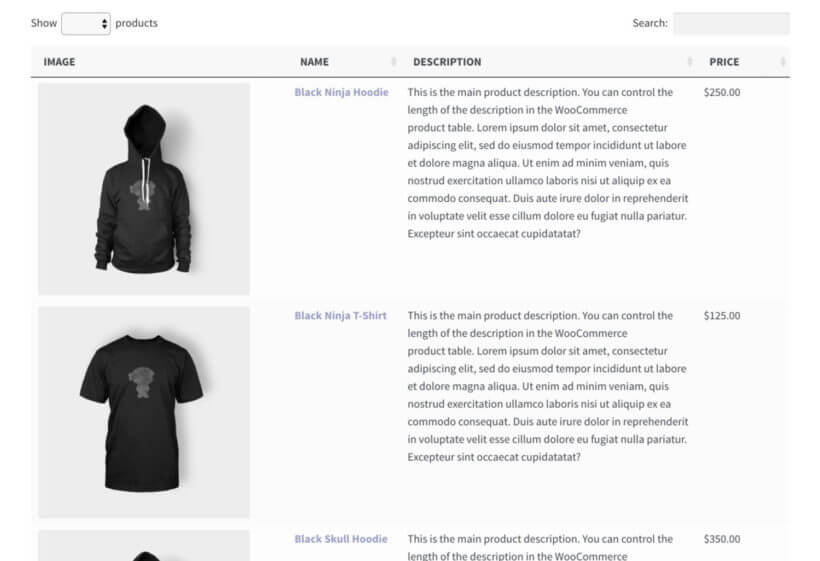
But ultimately, deciding on the right layout to use comes down to which one best suits your particular customers. With smaller purchase quantities and less need for quick purchases, your imaginary boutique clothing store is likely to benefit from the highly visual layout characteristic of the standard WooCommerce shop format.
Create a quick WooCommerce order form today 🚀
How your customers want to shop should dictate your store's product layout. The default WooCommerce shop layout works for customers who are happy to take their time browsing images and reading descriptions. But, when your customers need to buy multiple items quickly, a WooCommerce order form plugin is a much better solution.
We'd love to see your WooCommerce form – share your website in the comments below. We might even link to it from the WooCommerce Product Table showcase!
